Controlling annual bluegrass on golf course putting greens
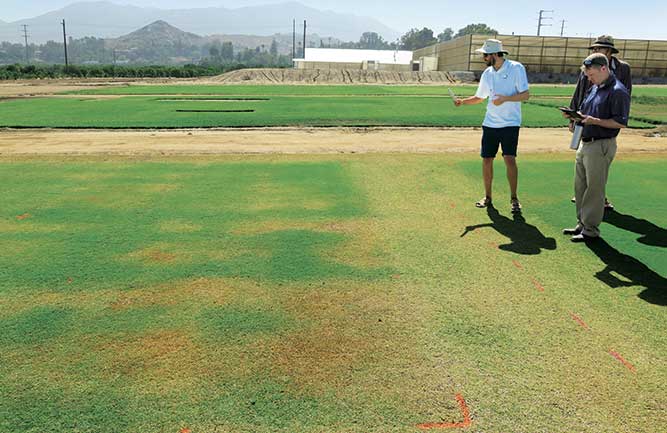
Figure 1 Study area being prepared for an application on Sept. 23, 2014. Three injured plots are evident from a late August application of Bensumec followed by early September Velocity applications. The treatment was discontinued shortly thereafter. (Photo: Daniel Weisenberger)
Annual bluegrass (Poa annua L.; ABG) is a common turfgrass weed that is well adapted to low mowing heights and is the most problematic on golf course putting greens. It usually encroaches creeping bentgrass (Agrostis stolonifera L.) putting greens after establishment, spreads in the spring and the fall and often declines in summer.
Cultural practices such as interseeding creeping bentgrass cultivars with increased density, collecting clippings during ABG seedhead production, interseeding creeping bentgrass, reducing shade and reducing nitrogen (N) and phosphorus (P) fertilization partially reduce annual bluegrass in creeping bentgrass putting greens (9, 11, 19, 21). Further, applications of iron sulfate or “ferrous sulfate” (FeSO4 · 7H2O) fertilizer have reduced populations of ABG in full sun (3, 10, 12) but not in shaded conditions where iron applications encouraged ABG (22).
Though perennial biotypes of ABG exist, it is commonly a winter annual that germinates primarily in the fall. In Maryland, as much as 75 percent of ABG can germinate between September and November on golf course roughs (15). However, in Michigan, ABG germinates almost equally well in the fall and spring (6).
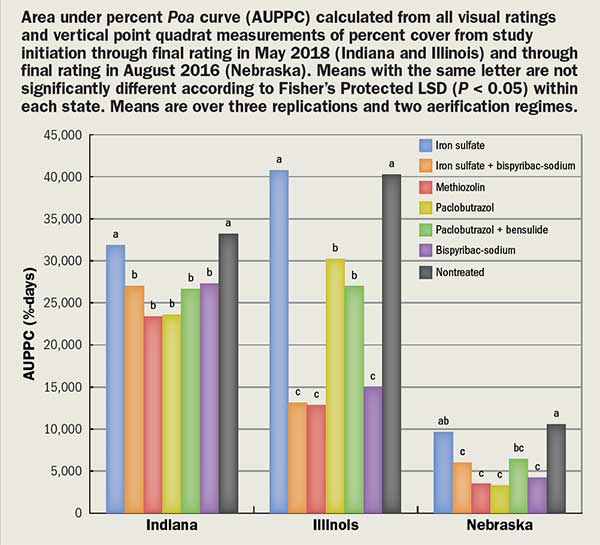
Figure 2
One suggestion to reduce ABG infestation is summer core aerification to avoid cultivating in the fall when ABG germinates (8). However, there is no research examining this idea.
Comparisons of plant growth regulators (PGRs) and herbicides with treatments of iron sulfate could provide insight on nutritional approaches to ABG control. A recent four-year experiment evaluated individual PGR and herbicide active ingredients applied up to 12 times per year in three different U.S. states (20). Some active ingredients were more useful for ABG control in one environment than in others. Trimmit (paclobutrazol) was the most effective in Indiana and Michigan but was in the second tier of performers in Nebraska.
Recent work in the Pacific Northwest on golf course putting greens also showed that ABG control with PGRs varies among locations (2). Therefore, multilocation experiments are necessary if we hope to develop effective ABG control programs across different growing environments and biotypes.
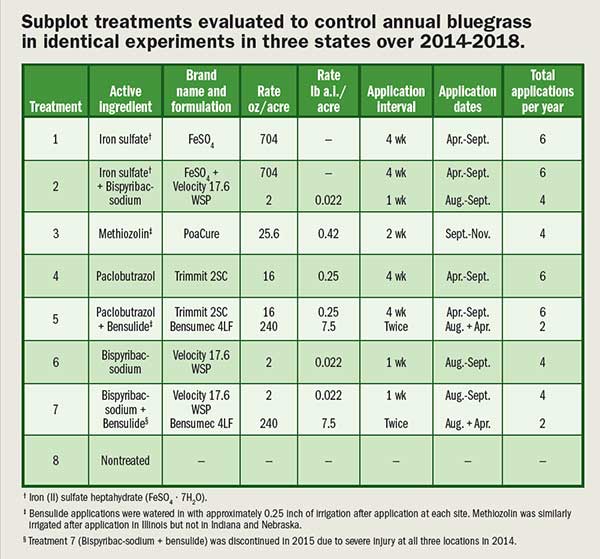
Table 1
Fall applications of preemergence herbicides are effective at reducing ABG populations in cool-season fairways and roughs. Though many labeled active ingredients exist for fairways, few options exist for putting greens. The use of preemergence herbicides for ABG control on putting greens is rare because of the risk of root injury. Further, preemergence herbicides will only prevent further ABG establishment from seed but have little activity on established ABG or perennial ABG biotypes.
Of the two preemergence herbicides labeled for putting greens, Bensumec (bensulide) is considered safer than Dimension (dithiopyr) when applied to creeping bentgrass (13). We investigated the timing of summer aerification along with spring and fall applications of preemergence herbicides in this research to minimize germination and encroachment of ABG.
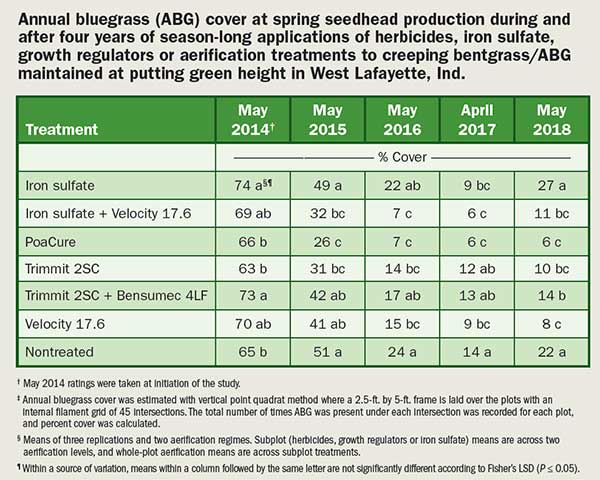
Table 2
Among herbicides, PoaCure (methiozolin) can control ABG on putting greens with both pre- and postemergence activity with adequate safety on creeping bentgrass (4, 16, 18). Velocity (bispyribac-sodium) is another effective herbicide for controlling ABG in cool-season fairways (17). Although promising, the label for Velocity does not permit use on golf course putting greens, and its production was ceased in 2017 after this research was initiated.
Creating a system that uses multiple methods (cultural, PGR, herbicides) to manage ABG will help limit the development of ABG populations resistant to a particular herbicide. Currently, 35 cases of herbicide-resistant ABG in turf are reported (14). Most of these are on warm-season turf with repeated use of herbicides having the same mode of action. Repeated use of herbicides or growth regulators in creeping bentgrass golf greens is known to cause genetic shifts after only two or three years of season-long applications (5). Recent models predict that even with proper herbicide rotation, annual bluegrass resistance to herbicides will occur within 35 years (7).
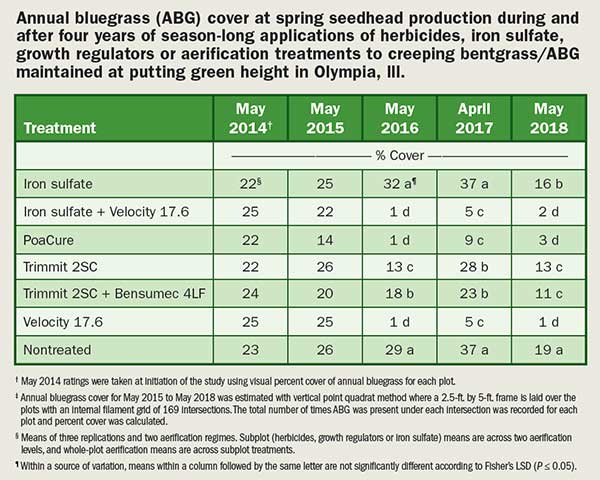
Table 3
With all of this in mind, our research evaluates the longer-term impact of a systems approach to ABG control on putting greens. We evaluated that seven season-long programs of plant growth regulators, herbicides and iron sulfate fertilizer with summer or early fall aerification timing across diverse locations is needed to help equip superintendents with a better understanding of control strategies.
Regional examination of annual bluegrass control
We conducted studies on putting greens with a mixture of creeping bentgrass and ABG at Kampen Golf Course in West Lafayette, Ind.; Olympia Fields Country Club in Olympia, Ill.; and Fremont Golf Club in Fremont, Neb. We used a replicated split-plot design with aerification treatments as the whole plots and spray treatments as the subplots (Table 1). Aerification treatments included a July hollow-tine aerification (at any time between July 10 and July 28); or a September hollow-tine aerification (between Sept. 9 and 22). After harvesting aerification plugs, greens were sand topdressed to fill aerification holes. At each site, aerification tine size and spacing were determined by the local superintendent to affect more than 3 percent of the surface area.
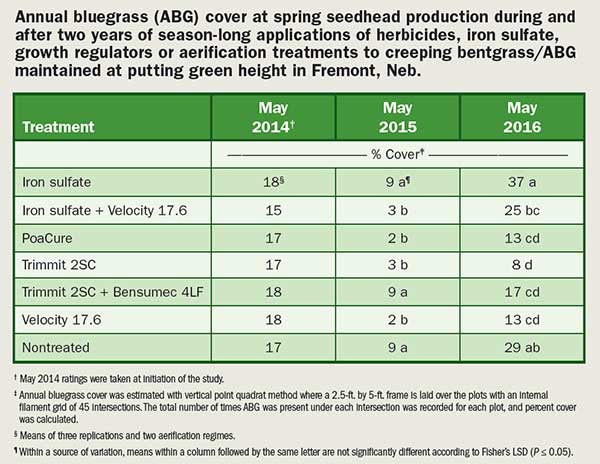
Table 4
The application treatments of herbicides, growth regulators or iron sulfate were in an 80-gallon-peracre spray solution. The applied rates followed recommendations from the label, company representatives, golf course superintendents, as well as previous research experience. We applied the treatments up to six times per year on four-week intervals (Table 1). Applications began at the end of April or early May 2014 and continued through fall 2017 in Indiana and Illinois and through August 2016 in Nebraska.
In 2014, at all three locations, Bensumec 4LF (bensulide) applied in September after season-long use of Velocity 17.6 WSP (bispyribac-sodium) caused significant phytotoxicity and subsequent thinning of creeping bentgrass. Thus, we stopped the bispyribac- sodium + bensulide treatment after 2014 (Table 1, Figure 1).
We recorded visual ratings of ABG cover, turf quality and turfgrass phytotoxicity throughout each growing season. All visual estimates of percent cover were plotted over days from study initiation through the final rating in May 2018. We present this data as the area under the percent Poa curve (AUPPC). The AUPPC is similar to the area under the disease progress curve and provides a long-term summary of ABG cover with lower AUPPC values indicating a decrease in ABG cover.
July and September aerification
Except for initial ratings in May 2014 in Illinois, aerification timing was not significant for ABG cover. Further, we did not find significant aerification by treatment interactions for ABG cover, which indicates that ABG populations were not affected by cultivation timing (July vs. September). This conflicts with recommendations that promote summer aerification instead of fall aerification to reduce ABG infestation (8). However, we performed the early fall aerification in September in this experiment, and aerifying later in the fall could promote ABG encroachment due to documented seedling emergence between late September and early October (15). We also did not compare aerification to no aerification in our study. No aerification would minimize the surface disturbance and thus possibly exclude or diminish the potential for ABG invasion.
Herbicide and plant growth regulator programs
Since there was significant treatment by location interaction, we analyzed the three sites separately. For AUPPC, the main treatment effect was significant for all three locations and across multiple rating dates for percent visual ABG cover (Figure 2).
Only the Velocity + Bensumec caused significant damage to creeping bentgrass. Bensumec applied in August followed by two Velocity applications caused unexpected phytotoxicity on creeping bentgrass at all three locations in 2014, and therefore, this treatment was discontinued after 2014 (Figure 1). As such, turf managers should avoid using site-specific programs that apply Velocity and Bensumec within a calendar year. All other treatments had acceptable turfgrass quality (≥ 6 rating) at all three sites on all rating dates, with a few minor exceptions (data not shown). These few exceptions of below-acceptable turf quality occurred in Nebraska only with Trimmit + Bensumec in 2014 (data not shown).
In Indiana, all treatments except monthly applications of iron sulfate reduced AUPPC or ABG coverage compared with the nontreated plots by the end of the study, with PoaCure, Trimmit, Trimmit + Bensumec, iron sulfate + Velocity or Velocity equally effective (Figure 2 and Table 2). PoaCure and iron sulfate + Velocity reduced ABG coverage compared with the nontreated plots in all four years of the study in Indiana (Table 2). Similarly, PoaCure also selectively controlled ABG when applied in the spring or fall in Tennessee, Texas and Virginia (1, 4).
Velocity effectively reduced ABG in this putting green experiment similar to previous research in creeping bentgrass fairways (18). In a 2015 study, Trimmit also was one of the most effective treatments at reducing ABG in putting greens (20). All treatments except iron sulfate reduced visual ABG cover at the final rating compared with the nontreated plots (Table 2). For Indiana, the nontreated plots decreased in ABG cover from 65 percent at the initial spring 2014 evaluations to 22 percent in the spring of 2018 (Table 2).
The reason was unclear but likely due to hotter summers. PoaCure, Velocity and iron sulfate + Velocity were most effective at reducing AUPPC in Illinois, while iron sulfate was again the only treatment that did not decrease AUPPC compared with the nontreated plots (Figure 2). Similarly, Velocity, iron sulfate + Velocity and PoaCure reduced ABG cover to less than 3 percent (Table 3). Nontreated plots decreased from 23 to 19 percent during the same four-year period.
The Nebraska experiment only ran from 2014 to 2016 due to the loss of turfgrass on more than half of the golf course putting green at the end of 2016.
The loss of turf was due to the removal of a tree next to the putting green and not a treatment effect. Only PoaCure and Velocity decreased ABG coverage in both April 2015 and April 2016 compared with the nontreated plots (Table 4).
Recommendations for annual bluegrass control
Our data indicate that aerifying golf course putting greens in July instead of early September did not reduce ABG infestation. Golf course superintendents located in climates just north of the Transition Zone, like the golf courses in this experiment, have flexibility in scheduling cultivation in July to early September without concern for influencing ABG encroachment.
In colder climates, such as parts of the Upper Midwest and Northeast, annual bluegrass may germinate earlier and may be more likely to invade during the September aerification dates we tested.
Our data also indicate that monthly application of iron sulfate alone is not an effective ABG control strategy on golf course putting greens. Iron sulfate did not reduce ABG but turned the turf and especially ABG a darker green, thus masking the ABG within the creeping bentgrass. Similar research in Pennsylvania (12) documented a decrease in ABG from iron applications when annual nitrogen rates were 0.5 lb. N per 1,000 sq. ft. per year, but not at 3.0 lb. N per 1,000 sq. ft., per year tested in our research. In a separate Virginia experiment (10), ABG decreased from iron applications when nitrogen was 3.0 lb. N per 1,000 sq. ft. per year. This decrease in ABG may be due to the 14-day application frequency used compared with the 28-day interval in our study. Our results from monthly applications do not support the use of iron for ABG control; however, other factors such as nitrogen rate and iron application frequency may increase the ABG control.
The effectiveness of season-long treatments will vary depending on location, but PoaCure (WSSA Group 30 herbicide), Trimmit (Type II, Class B PGR) or Velocity (WSSA Group 2 herbicide) reduced ABG populations.
These three options with diverse modes of action may be useful in an ABG management system that also includes mechanical removal, interseeding of improved creeping bentgrass cultivars, the reduction of tree shade on putting greens and careful management of nitrogen and phosphorus inputs.
Recently, PoaCure received registration for use in the U.S. However, Velocity is not labeled for use on putting greens, and its future is uncertain in the U.S. Trimmit also was a useful product that is available for use on putting greens. Products such as PoaCure and Trimmit provide needed options to allow for the rotation or addition of multiple control strategies coupled with cultural control practices in an ABG control system to limit resistance development.
Research takeaways
- Annual bluegrass (Poa annua L.; ABG) is among the most common weeds of highly maintained turf in the United States.
- In three Midwestern U.S. states, the researchers conducted a four-year systems approach experiment to control ABG on putting greens by examining seven season-long programs of plant growth regulators, herbicides and iron sulfate fertilizer with a July or September hollow-tine aerification.
- Aerification timing did not influence annual bluegrass cover at the three locations.
- Monthly applications of iron sulfate alone did not effectively control ABG.
- The effectiveness of season-long treatments varied by location, but PoaCure (methiozolin), Trimmit (paclobutrazol) or Velocity (bispyribac-sodium) consistently reduced ABG. None completely removed annual bluegrass.
Aaron Patton, Ph.D. is Professor of Horticulture, Purdue University, and can be reached at ajpatton@purdue.edu. Ross Braun, Ph.D., Geoffrey Schortgen, Daniel Weisenberger, Dept. of Horticulture and Landscape Architecture, Purdue University. Bruce Branham, Ph.D., Bill Sharp, University of Illinois. Matthew Sousek and Roch Gaussoin, Ph.D., University of Nebraska. Zach Reicher, Ph.D., Bayer Crop Sciences.
Acknowledgments
The authors want to express their gratitude to the United States Golf Association for funding this research. The authors would also like to thank golf course superintendents Dennis Kitzelman, Sam Mackenzie and Jim Scott for hosting this experiment at their courses.
This work was supported by Hatch project 1004762 from the USDA National Institute of Food and Agriculture. The full manuscript on the experiment is available in Crop, Forage & Turfgrass Management (https://doi.org/10.2134/cftm2018.09.0068).
References
1. Askew, S.D., and B.M.S. McNulty. 2014. Methiozolin and cumyluron for preemergence annual bluegrass (Poa annua) control on creeping bentgrass (Agrostis stolonifera) putting greens. Weed Technol. 28:535–542. doi:10.1614/WT-D-14-00018.1
2. Baldwin, C.M., and A.D. Brede. 2011. Plant growth regulator selection and application rate influence annual bluegrass control in creeping bentgrass putting greens. Appl. Turfgrass Sci. doi:10.1094/ATS-2011-0517-02-RS
3. Bell, G.E., E. Odorizzi, and T.K. Danneberger. 1999. Reducing populations of annual bluegrass and roughstalk bluegrass in creeping bentgrass fairways: A nutritional approach. Weed Technol. 13(4):829–834. doi:10.1017/S0890037X00042305
4. Brosnan, J.T., G.M. Henry, G.K. Breeden, T. Cooper, and T.J. Serensits. 2013. Methiozolin efficacy for annual bluegrass (Poa annua) control on sand-and soil-based creeping bentgrass putting greens. Weed Technol. 27:310–316. doi:10.1614/WT-D-12- 00123.1
5. Brown, J. 2013. Changes in Poa annua populations in response to herbicides and plant growth regulators. M.S. thesis, Univ. of Nebraska–Lincoln, Lincoln.
6. Calhoun, R.N. 2010. Growing degree-days as a method to characterize germination, flower pattern, and chemical flower suppression of a mature annual bluegrass [Poa annua var reptans (Hauskins) Timm] fairway in Michigan. Ph.D. diss., Michigan State University.
7. Cross, R.B., W.C. Bridges, Jr., L.B. McCarty, and J.S. McElroy. 2015. Evaluating annual bluegrass herbicide resistance evolution in golf course fairways. Weed Technol. 29:488–500. doi:10.1614/ WT-D-14-00151.1
8. Dernoeden, P.H. 2013. Creeping bentgrass management. CRC Press, Boca Raton, FL. p. 362.
9. Engel, R.E. 1974. Influence of nitrogen fertilization on species dominance in turfgrass mixtures. In: E.C. Roberts, editor, Proc. 2nd Int. Turfgrass Res. Conf., Blacksburg, VA. June 1973. ASA and CSSA, Madison, WI. p. 104–111.
10. Ervin, E.H., N. Reams, X. Zhang, A. Boyd, and S. Askew. 2017. An integrated nutritional and chemical approach to Poa annua suppresion in creeping bentgrass greens. Crop Sci. 57:567–572. doi:10.2135/cropsci2016.05.0308
11. Gaussoin, R.E., and B.E. Branham. 1989. Influence of cultural factors on species dominance in a mixed stand of annual bluegrass/ creeping bentgrass. Crop Sci. 29:480–484. doi:10.2135/cropsci1 89.0011183X002900020048x
12. Han, K.Y., J.E. Kaminski, and T.T. Lulis. 2017. Influence of nitrogen, plant growth regulators, and iron sulfate on annual bluegrass populations on golf green. Int. Turfgrass Soc. Res. J. 13:661–669. doi:10.2134/itsrj2016.05.0402
13. Hart, S., D.W. Lycan, and J. Murphy. 2004. Response of creeping bentgrass greens to fall applications of bensulide and dithiopyr. Proc. Annu. Meet. Northeast. Weed Sci. Soc. 58:121.
14. Heap, I. 2020. The international survey of herbicide resistant weeds. www.weedscience.org.
15. Kaminski, J.E., and P.H. Dernoeden. 2007. Seasonal Poa annua L. seedling emergence patterns in Maryland. Crop Sci. 47:775–781. doi:10.2135/cropsci2006.03.0191w
16. Koo, S.J., K.-H. Hwang, M.-S. Jeon, S.-H. Kim, J. Lim, D.-G. Lee, and N.-G. Cho. 2013. Methiozolin [5-(2,6-difluorobenzyl)oxymethyl- 5-methyl-3,3(3-methylthiophen-2-yl)-1,2-isoxazoline], a new annual bluegrass (Poa annua L.) herbicide for turfgrasses. Pest Manag. Sci. 70:156–162. doi:10.1002/ps.3541
17. McCullough, P.E., and S.E. Hart. 2006. Temperature influences creeping bentgrass (Agrostis stolonifera) and annual bluegrass (Poa annua) response to bispyribac-sodium. Weed Technol. 20:728–732. doi:10.1614/WT-05-010R2.1
18. McCullough, P.E., D.G. de Barreda, and J. Yu. 2013. Selectivity of methiozolin for annual bluegrass (Poa annua) control in creeping bentgrass as influenced by temperature and application timing. Weed Sci. 61:209–216. doi:10.1614/WS-D-12-00135.1
19. Raley, R.B., P.J. Landschoot, and J.T. Brosnan. 2013. Influence of phosphorus and nitrogen on annual bluegrass encroachment in a creeping bentgrass putting green. Int. Turfgrass Soc. Res. J. 12:649–655.
20. Reicher, Z., M. Sousek, A. Patton, D. Weisenberger, A. Hathaway, and R. Calhoun. 2015. Annual bluegrass control on putting greens from three or four years of season-long applications of herbicides or plant growth regulators in three states. Crop Forage Turfgrass Manage. doi:10.2134/cftm2014.0050
21. Skogley, C.R. 1975. Velvet bentgrass putting greens–fertilizer and topdressing management. USGA Green Sec. Rec. 13(5):7–9.
22. Stiegler, J.C., G.E. Bell, and D.L. Martin. 2003. Foliar applications of magnesium and iron encourage annual bluegrass in shaded creeping bentgrass putting greens. Crop Manage. doi:10.1094/CM-2003-0821-01-RS










